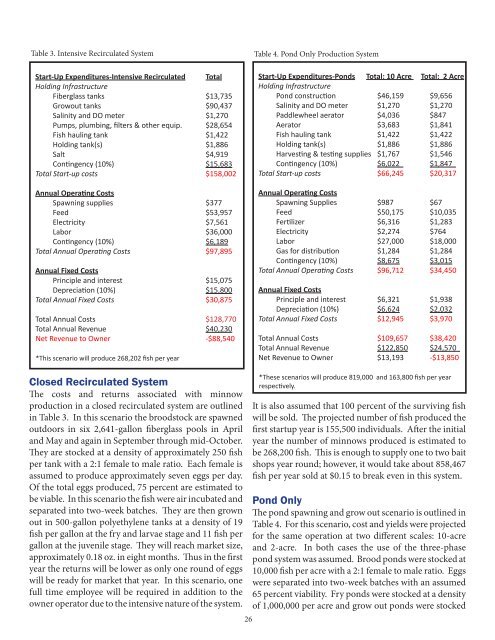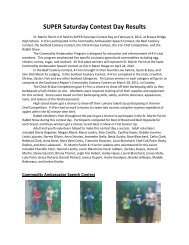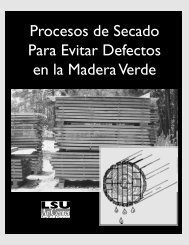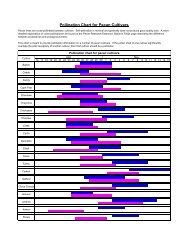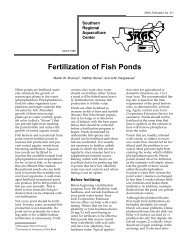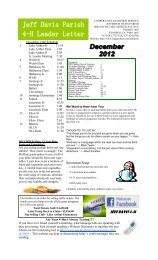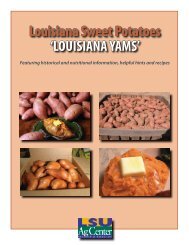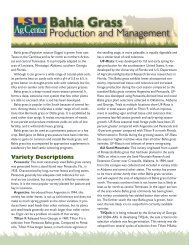Cocahoe Minnow - The LSU AgCenter
Cocahoe Minnow - The LSU AgCenter
Cocahoe Minnow - The LSU AgCenter
Create successful ePaper yourself
Turn your PDF publications into a flip-book with our unique Google optimized e-Paper software.
Table 3. Intensive Recirculated System<br />
Start-Up Expenditures-Intensive Recirculated Total<br />
Holding Infrastructure<br />
Fiberglass tanks $13,735<br />
Growout tanks $90,437<br />
Salinity and DO meter $1,270<br />
Pumps, plumbing, filters & other equip. $28,654<br />
Fish hauling tank $1,422<br />
Holding tank(s) $1,886<br />
Salt $4,919<br />
Contingency (10%) $15,683<br />
Total Start-up costs $158,002<br />
Annual Operating Costs<br />
Spawning supplies $377<br />
Feed $53,957<br />
Electricity $7,561<br />
Labor $36,000<br />
Contingency (10%) $6,189<br />
Total Annual Operating Costs $97,895<br />
Annual Fixed Costs<br />
Principle and interest $15,075<br />
Depreciation (10%) $15,800<br />
Total Annual Fixed Costs $30,875<br />
Total Annual Costs $128,770<br />
Total Annual Revenue $40,230<br />
Net Revenue to Owner -$88,540<br />
*This scenario will produce 268,202 fish per year<br />
Closed Recirculated System<br />
<strong>The</strong> costs and returns associated with minnow<br />
production in a closed recirculated system are outlined<br />
in Table 3. In this scenario the broodstock are spawned<br />
outdoors in six 2,641-gallon fiberglass pools in April<br />
and May and again in September through mid-October.<br />
<strong>The</strong>y are stocked at a density of approximately 250 fish<br />
per tank with a 2:1 female to male ratio. Each female is<br />
assumed to produce approximately seven eggs per day.<br />
Of the total eggs produced, 75 percent are estimated to<br />
be viable. In this scenario the fish were air incubated and<br />
separated into two-week batches. <strong>The</strong>y are then grown<br />
out in 500-gallon polyethylene tanks at a density of 19<br />
fish per gallon at the fry and larvae stage and 11 fish per<br />
gallon at the juvenile stage. <strong>The</strong>y will reach market size,<br />
approximately 0.18 oz. in eight months. Thus in the first<br />
year the returns will be lower as only one round of eggs<br />
will be ready for market that year. In this scenario, one<br />
full time employee will be required in addition to the<br />
owner operator due to the intensive nature of the system.<br />
26<br />
Table 4. Pond Only Production System<br />
Start-Up Expenditures-Ponds Total: 10 Acre Total: 2 Acre<br />
Holding Infrastructure<br />
Pond construction $46,159 $9,656<br />
Salinity and DO meter $1,270 $1,270<br />
Paddlewheel aerator $4,036 $847<br />
Aerator $3,683 $1,841<br />
Fish hauling tank $1,422 $1,422<br />
Holding tank(s) $1,886 $1,886<br />
Harvesting & testing supplies $1,767 $1,546<br />
Contingency (10%) $6,022 $1,847<br />
Total Start-up costs $66,245 $20,317<br />
Annual Operating Costs<br />
Spawning Supplies $987 $67<br />
Feed $50,175 $10,035<br />
Fertilizer $6,316 $1,283<br />
Electricity $2,274 $764<br />
Labor $27,000 $18,000<br />
Gas for distribution $1,284 $1,284<br />
Contingency (10%) $8,675 $3,015<br />
Total Annual Operating Costs $96,712 $34,450<br />
Annual Fixed Costs<br />
Principle and interest $6,321 $1,938<br />
Depreciation (10%) $6,624 $2,032<br />
Total Annual Fixed Costs $12,945 $3,970<br />
Total Annual Costs $109,657 $38,420<br />
Total Annual Revenue $122,850 $24,570<br />
Net Revenue to Owner $13,193 -$13,850<br />
*<strong>The</strong>se scenarios will produce 819,000 and 163,800 fish per year<br />
respectively.<br />
It is also assumed that 100 percent of the surviving fish<br />
will be sold. <strong>The</strong> projected number of fish produced the<br />
first startup year is 155,500 individuals. After the initial<br />
year the number of minnows produced is estimated to<br />
be 268,200 fish. This is enough to supply one to two bait<br />
shops year round; however, it would take about 858,467<br />
fish per year sold at $0.15 to break even in this system.<br />
Pond Only<br />
<strong>The</strong> pond spawning and grow out scenario is outlined in<br />
Table 4. For this scenario, cost and yields were projected<br />
for the same operation at two different scales: 10-acre<br />
and 2-acre. In both cases the use of the three-phase<br />
pond system was assumed. Brood ponds were stocked at<br />
10,000 fish per acre with a 2:1 female to male ratio. Eggs<br />
were separated into two-week batches with an assumed<br />
65 percent viability. Fry ponds were stocked at a density<br />
of 1,000,000 per acre and grow out ponds were stocked


